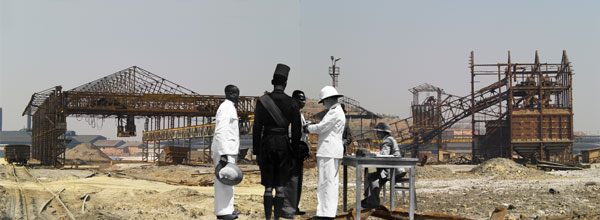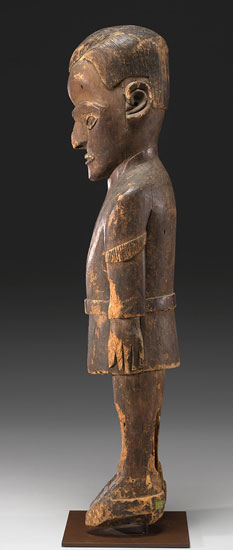Introduction: Visions from the Congo
Environment and Object: Recent African Art, shown at Virginia Commonwealth University’s Anderson Gallery in fall 2011, explored the work of sixteen contemporary artists from across the continent, of whom several now reside outside of Africa.
 |
Sammy Baloji (Democratic Republic of the Congo, born 1976) |
While planning VCU’s venue, Anderson Gallery director Ashley Kistler contacted me about possible links with the African art collection at the Virginia Museum of Fine Arts. Her welcome suggestion to collaborate required that I look at situations underlying the works of art in the VCU exhibition rather than search for formal similarities between the older works and the new.
| The five loaned objects in the Virginia Museum of Fine Art’s A Rising of the Wind and the two 20th century African American works by Sarr and Stout from the VMFA collection were exhibited as Visions from the Congo: Ancestral Contact, opening simultaneously with VCU Anderson Gallery's Environment and Object. | |
In view of the troubling conditions of physical, political, and social environment that the artists in Environment and Object engage in their work, I started to examine responses by earlier generations of African artists to difficult issues that they encountered. My focus settled on works stemming from the wrenching changes brought about by the colonial administration and commercial exploitation of the Congo during the first half of the 20th century.
Generous loans from several collectors open a window on events affecting the Pende people in Congo’s Kwilu province and their unimaginably difficult experience at the hands the colonial regime and international commercial interests in quest of palm oil. Years of coerced labor, taxation, and abuses ultimately led to a rebellion that lasted from May to September 1931. A Pende sculptor’s unprecedented statue depicting the Belgian colonial agent Maximilien Balot, featured in this issue of Blackbird, relates directly to the uprising in 1931 and conveys the abhorrence that the Pende harbored toward their oppressors.
 |
Diviner’s Figure representing Belgian Colonial Officer, Maximilien Balot, 1931 |
This uncharacteristic and challenging figure became the pivotal work for the VMFA show, which several other sculptures help set into an artistic and cultural context. Words from a Pende cleric, Abbé Gusimana, spoken in retrospect about the rebellion, were adopted for naming this section of the VMFA exhibition A Rising of the Wind.
The Anderson Gallery’s Environment and Object show included photographic montages by Congolese artist Sammy Baloji (b. 1976) in which the artist superimposed archival colonial era images on his own panoramic shots of today’s derelict industrial landscapes in Congo’s Katanga province. The resulting scenes, such as Untitled 21, are the only works in Environment and Object to make an historic visual reference to the colonial period. The overlay of past and present provides a poignant tie to the Pende colonial statue of Maximilien Balot. However, Baloji’s montage, and the story behind the industrial landscape, is quite different from the details underlying the statue of Balot.
 |
| Sammy Baloji (Democratic Republic of the Congo, born 1976) Untitled 21 (detail), 2006 Archival digital photograph on satin matte paper; 24 in. x 64 ½ in. Courtesy of the artist and Axis Gallery, New York. |
To broaden the scope of the VMFA installation and forge a connecting link to our time, major works by Alison Saar and Renée Stout—distinguished African American artists whose careers are in full stride today—accompany A Rising of the Wind. Their life-size figures attest to the vitality and power of Congolese art from the past and the inspiration it offers to artists in the present. Thus, the five loaned objects in A Rising of the Wind and the two 20th century African American works from the VMFA collection were exhibited as Visions from the Congo: Ancestral Contact, opening simultaneously with Environment and Object and remaining on view at VMFA through 2012. ![]()
Visions from the Congo is organized by the Virginia Museum of Fine Arts and curated by Richard B. Woodward, Curator of African Art.
Introduction: Visions from the Congo
A Rising of the Wind: Art from a Time of Rebellion in the Congo
Things Man Made: Allison Saar’s Untitled (from the Crossroads installation)
Goddess of Love and Beauty: Renée Stout’s Erzulie Dreams